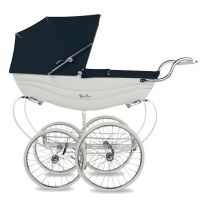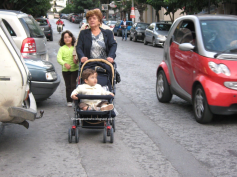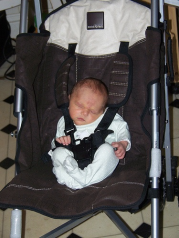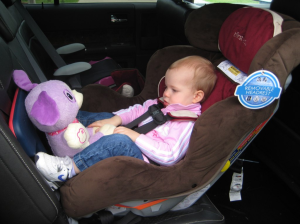How Strollers and Buggies Shape Babies’ Brains
In 2008, I released a small piece of research that caused an international storm. It tried to make a simple point: that the design of strollers shapes our children’s emotional and brain development. The study was, at the time, the only piece of empirical research that I could find that had even tried to explore that possibility.
I thought that parents and manufacturers deserved to know that strollers were important. So did the National Literacy Trust, who commissioned the research, and the Sutton Trust, who funded it.
That shows the far-ranging interest in this issue. The National Literacy Trust is an organization interested in reading, and the Sutton Trust is an educational charity. Yet both of them were interested in baby buggies. They had teachers behind them, urging them to give serious consideration to the idea that strollers could be influencing language development. Primary teachers have been witnessing a steady decrease in children’s linguistic abilities upon starting school, and they had wondered if the fact that so many strollers are now designed to face outward, rather than toward the adult, might be one of a variety of possible factors contributing to that decrease.

So the aim of our 2008 study was simple: to be able to confirm whether or not the direction that a stroller faces has a significant impact on how adults interact with their baby. The take home message of the study was that it does. We found that simply turning the buggy around doubles the amount of conversation that babies experience. The most surprising thing we discovered, once we looked closely at what was happening for children on High Streets in Britain, was just how infrequently babies seemed to be taking part in conversations with parents. Of the nearly 3000 observations that volunteers made of parent-child pairs, talking was observed in only 22% of those observations. Talking was twice as likely to be happening when children were being carried or walking (more than 40%) than when they were in strollers (less than 20%).
The media’s coverage of that story – including an invited Op-Ed piece in the New York Times – made it a bumpy and confusing ride for parents across the globe. The international storm extended from France to India to Australia and beyond. Responses from parents and professionals alike ranged from “I am so relieved to see that a scientist is finally talking about this” to “Utter hogwash”.
Well, guess what? A new study carried out in New Zealand has just replicated those earlier findings. It was carried out by Dr. Ken Blaiklock at the Unitec Institute of Technology in New Zealand, recently published in the New Zealand Research in Early Childhood Education Journal.
Blaiklock’s study showed the same three key patterns as the 2008 UK study. First, the amount of conversation observed to be occurring within parent-child pairs, out walking in public spaces, was very low. Blaiklock’s observations showed that they were even lower in New Zealand (5%) than in the UK (22%). Second, conversations were more likely to be going on when strollers faced toward the pusher (8%) than when the stroller faced away (.5%). Finally, outward-facing strollers are by far the most common model, even for infants estimated to be below the age of 1 year (68% vs. 12% of observations where a stroller was being used as transport, the remainder of his observations comprised of supermarket trolleys (3%) and infants being carried (17%)). Blaiklock concluded: “It is possible that parents may not always be aware of the value of making use of the one-to-one interaction opportunities that occur when accompanying children in prams.”
How do we help the public to think about this issue in more depth? How do we do that without causing parents to be alarmed or to feel guilty? That’s what happened in 2008. The media’s coverage of the story led parents to feel worried and defensive. The language used didn’t help parents to feel curious or informed. The coverage made it seem like a rather silly, over-stated issue.
I continue to think, though, that parents do want to know about this information. I remember in particular one of the mothers who took part in that 2008 study. Like all the participating parents, we had invited her to take her baby out for a walk in a stroller that we’d provided, which faced either outward or inward. Half way along, myself or one of my students met the parents and helped them switch to a stroller that faced the other direction. This mum came back from that walk saying, “I had no idea how much of a difference the direction of a stroller would make. We had such a good time when she faced me. I am off right now to buy a new stroller.” And she did! I wanted to send a request to Mothercare for a commission on the sale they had just made because of my research study.

I think also about the difference that this information makes for children in nursery. VIP Childcare, based in Elgin, makes a point of taking the children they care for outside every day. They decided to replace their outward-facing double-buggies with inward-facing ones, even though this was at some cost. Very creatively, they carried out a systematic observation of the children’s experience in the buggies they were using before and after. They were able to show a definite change in the children’s behaviour and experience. Even the staff reported higher levels of enjoyment when out on a walk.
 Why should strollers matter so much? The stroller years are precisely those when human brains are developing more rapidly than they every will again. Young brains are being shaped by every single tiny experience that a child has. If outward-facing buggies significantly decrease the amount of chat that a baby gets to have, that will inevitably be impacting on language development. If the world that the baby is looking out to is alarming, because it is full of loud traffic, shopping bags, and random adults’ knees, then the baby might end up a bit anxious. It’s understandably easy for busy parents to overlook that anxiety or the opportunity for chatter when they are feeling hassled, trying to negotiate all that traffic, and they can’t hear the baby or see his/her facial expressions.
Why should strollers matter so much? The stroller years are precisely those when human brains are developing more rapidly than they every will again. Young brains are being shaped by every single tiny experience that a child has. If outward-facing buggies significantly decrease the amount of chat that a baby gets to have, that will inevitably be impacting on language development. If the world that the baby is looking out to is alarming, because it is full of loud traffic, shopping bags, and random adults’ knees, then the baby might end up a bit anxious. It’s understandably easy for busy parents to overlook that anxiety or the opportunity for chatter when they are feeling hassled, trying to negotiate all that traffic, and they can’t hear the baby or see his/her facial expressions.
Most adults have no idea just how tuned in babies’ brains are to the environment around them. That’s why I show all those video clips of young babies in my talks. I’m trying to help us to think about how human brains work, how connected babies are from birth, how emotionally dependent they are on the people around them. Babies need us grown-ups to pay attention to their emotional needs. Babies have immature brains that mean they can’t yet manage those emotions themselves. They depend on our help to learn how to do that.
So: every minute of a baby’s experience is having an impact on their brain development. This includes the time that we adults think of as ‘in between’ time. While we may think of the time in the buggy as ‘just nipping into the shops before we get home’, the baby doesn’t know that. The time in the buggy is as ‘real’ for him or her as any other time.
 That doesn’t mean that parents have to pay attention to babies every second of the day. That’s a relief for parents. And it also confirms what parents know instinctively. Babies don’t need constant attention. It does mean, though, that they need enough attention.And they need it at crucial times. Babies especially need attention and comforting when they are feeling uncomfortable and at risk of being overwhelmed. It is in these moments that they most need reassurance, which comes through the responsiveness of someone they trust. It is through relationships that babies learn how to deal with their discomfort and anxiety. Having a buggy that faces away, especially probably during the first year, makes it more difficult to let your mum or dad know that you are needing them. The more time that babies have to spend in anxiety, the more their brain comes to expect anxiety, and thus goes on to actually create it.
That doesn’t mean that parents have to pay attention to babies every second of the day. That’s a relief for parents. And it also confirms what parents know instinctively. Babies don’t need constant attention. It does mean, though, that they need enough attention.And they need it at crucial times. Babies especially need attention and comforting when they are feeling uncomfortable and at risk of being overwhelmed. It is in these moments that they most need reassurance, which comes through the responsiveness of someone they trust. It is through relationships that babies learn how to deal with their discomfort and anxiety. Having a buggy that faces away, especially probably during the first year, makes it more difficult to let your mum or dad know that you are needing them. The more time that babies have to spend in anxiety, the more their brain comes to expect anxiety, and thus goes on to actually create it.
Once we get this far in the discussion, it becomes easy to realise that the logic applies to other forms of baby transport, especially slings (baby carriers) and car seats. Slings keep a baby close to a parent’s body, and thus in constant reassurance. This is why many parents choose to use them. Giving slings away to families living in ‘vulnerable circumstances’ would probably make a great health intervention.
Car seats, on the other hand, bring up many of the same challenges as strollers. Thelaws in many Western countries require that infant car seats be rear-facing in order to protect infants in the case of accident. While this protects their physical health, it may interfere with their emotional health, because it prevents the baby from seeking and making easy contact with the driver. That’s part of why a parent can easily end up in a fight getting the baby to settle into a car seat.
 Yet, the idea that car seats should be impacting on the development of infants’ brains and emotional health hasn’t been considered in the scientific literature or by professionals. That is one of the reasons that Jane Leavey has just founded the new UK-based organization BabyBWell. She is keen to help parents to understand more about the issues associated with car seat use. She advocates a 90 Minute Max Rule: never travel longer than 90 minutes without giving the baby a chance to get out of the car seat and move around, even if its ‘just’ in your arms. Indeed for a young baby, there’s no ‘just’ to it. There’s nowhere they would rather be than in a parent’s arms.
Yet, the idea that car seats should be impacting on the development of infants’ brains and emotional health hasn’t been considered in the scientific literature or by professionals. That is one of the reasons that Jane Leavey has just founded the new UK-based organization BabyBWell. She is keen to help parents to understand more about the issues associated with car seat use. She advocates a 90 Minute Max Rule: never travel longer than 90 minutes without giving the baby a chance to get out of the car seat and move around, even if its ‘just’ in your arms. Indeed for a young baby, there’s no ‘just’ to it. There’s nowhere they would rather be than in a parent’s arms.
And as I end this blog, I want to stress: this is not just an issue for parents. It is an issue for professionals, manufacturers, and retailers alike. There is virtually no discussion amongst any of these communities about the psychological importance of strollers and car seats. Blaiklock made that observation in his recent paper:
“The website (www.plunket.org) of Plunket (the largest provider of health and development services for children under five) provides much information on parenting and child development but makes no mention of the significance of orientation of prams…. The national consumer organisation in New Zealand recently published a review of children’s prams (Fredrikson, 2011). Again, no mention was made of the value of parent-facing prams for promoting interaction….The websites and stores of major retailers of children’s prams in New Zealand do not appear to provide information on the significance of using adult-facing prams.”
It is likely the members of these professional communities simply do not know, since even the scientists have not thought to gather data. When I was undertaking the preparations for my 2008 study, a colleague said to me, “Suzanne, you’re not really considering doing research on baby buggies are you? Do you not think you may put your reputation as a serious scientist at risk?” My shoulders hardened with my resolve.
A few manufacturers have begun to consider these issues. Graco hosted an event in 2011 that launched their new parent-facing model. The company Stokke has probably done the most of any company to think through their responsibility as designers. They have entitled their entire line of buggies ‘Connection Strollers’, and have made films that try to explain the importance of connection to consumers (see below). Some retailers have also tried to communicate the significance of connection to customers.
My view is that these commercial industries have a moral responsibility to learn about child development. The products they design, the items they sell, the advice they give have an impact on the brain development of our children. Parents and society at large are right to expect them to fulfill that duty.
They can perhaps be forgiven for not fulfilling that responsibility until now. Most probably did not know. But they can be expected to now, with your help.
Once you finish reading this blog, take one simple step. Tell someone who needs to know.
- Forward this blog to another parent or health visitor.
- Find out if your local pram supplier or the manufacturer of your stroller knows about this stuff.
- Drop an email to Dr. Ken Blaiklock (KBlaiklock@unitec.ac.nz) to thank him for being the only other scientist in the world to carry out an empirical study on strollers.
- Send a thank you to the editor of the New Zealand Research in Early Childhood Education Journal thanking her for making this research report an open access publication (Sarah@childforum.com). Not all scientific journals would have been willing to take this step.
- Call a local journalist and get them to do a story on this issue.
- Ask the nursery or childminder who cares for your child if they know about the report produced by VIP Childcare.
- Support Jane Leavey’s campaign at BabyBWell (www.babybwell.co.uk).
- Send a tweet to the Sutton Trust (@suttontrust) or the National Literacy Trust (@Literacy_Trust) to let them know that you are still reading the report that they funded in 2008, given that it was considered by some commentators at the time an ‘outrageous waste’ of money.
- See if there are any other funding agencies out there willing to be as courageously wasteful as the Sutton Trust :-).
Photo: Shutterstock/ipatov

